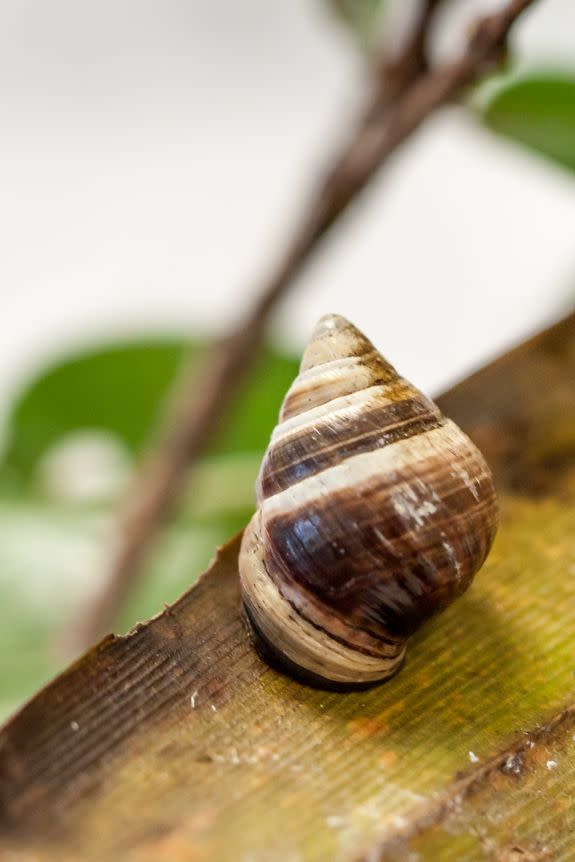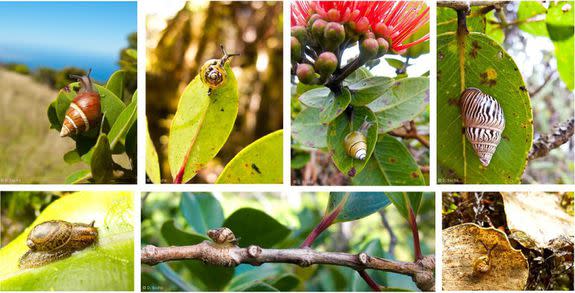George is dead and his species likely extinct. It’s the loss of a ‘crown jewel of evolution.’

A one-inch Hawaiian snail is dead, and his species is likely gone forever.
The New Year's Day death of the small, 14-year-old snail, named George by Hawaiian scientists, is yet another blow to the native Hawaiian ecosystem, which as the most isolated group of islands on the planet contains species found nowhere else.
But overexploitation, invasive predators, and climate change are continuously knocking out the critters here. And it's happening fast.
"We’re witnessing complete extirpations at a rate that’s pretty remarkable," David Sischo, the snail extinction prevention program coordinator at the Hawaii Department of Land and Natural Resources, said in an interview.
"Our staff has broken down and cried in the field before," said Sischo. "They’re not going extinct tomorrow — it's happening now."
A total of 752 land snail species have been identified in Hawaii, covering a range of 10 families. But in each family, between 60 to 90 percent of the species are now extinct.

Image: HAWAII DEPARTMENT OF LAND AND NATURAL RESOURCES
George's species, Achatinella apexfulva, was one of hundreds that evolved on these once inaccessible Pacific Islands. The idea is that a snail species — perhaps brought by wayward birds or floating debris — found its way to the Hawaiian island ages ago. Since then, the species flourished in diversity across Hawaii's hugely varied forests and elevations.
"Think of the process as something like a spectacular firework — one inconspicuous, lucky species travels an outrageous distance and then explodes into a breathtaking diversity of color or form," Sea McKeon, a biology professor at St. Mary's College of Maryland and co-host of The Naturalist Podcast, said over email. "George’s lineage of landsnails is one of these fireworks, and ‘his’ death is the most recent loss in a long series of human-induced extinctions."
(Note: Most snails are hermaphrodites, so George is not actually male as he naturally has both female and male sex organs.)
"Our world is slowly becoming less colorful, less vibrant with each loss, and only a few people are in a position to appreciate it," McKeon added.
SEE ALSO: These are the animals that went extinct in 2018
The number of land snail species in Hawaii once outnumbered all of the mollusk species in North America, noted Sischo. It was a profoundly diverse number of species packed into the relatively small islands. It was a natural and scientific wonderland.
Biologists agree that it's extremely daunting to officially label any species extinct. George was the last known member of his species, so while there could potentially be more Achatinella apexfulva out there hiding in a ravine, it's exceedingly unlikely. Sischo uses the careful phrasing "likely extinct."
"I’ve been scouring the mountains trying to find more," said Sischo. "People have been looking for them for well over 20 years."
George became the lone member of his species soon after he was born in a University of Hawaii laboratory, 14 years ago. But an unknown pathogen or illness swept over the captive species, killing everyone but George. A frozen sample of his cells was later collected, and is now stored at the San Diego Frozen Zoo — a lab containing over 10,000 living cell cultures, sperm, eggs, and embryos.

Image: Hawaii Department of land and natural resources
Before Achatinella apexfulva's demise, the species occupied forests ranging between 1,000 to 1,500 feet in the mountains of O'ahu, Hawaii's most populous island. Invasive species, which had been unwisely introduced to the island, wiped out most of the species. For the snails, the worst culprit is the rosy wolfsnail, introduced to the island to eliminate another pest, the giant African snail.
The plan backfired. The wolfsnails are now exterminating Hawaii's unique, native snails.
"It's essentially vacuuming up our snail fauna," said Sischo.
Making matters worse, climate change is exacerbating the plight of the Hawaiian snails. Some historically wet forests areas are drying out, straining the dwindling snails and inviting more wildfire.
"Climate change is exacerbating the issues," noted Sischo.
Hawaii — often labeled the "extinction capital of the world" — has seen the rapid demise of a variety of unique critters. According to the American Bird Conservatory, 95 of 142 bird species found nowhere else on Earth have gone extinct on Hawaii. Just last year, biologists concluded that Hawaii's insect-eating forest-bird, the poʻouli, is now extinct. The Hawaiian herb, Amaranthus brownii, was placed on the infamous extinction list in 2018.
Snails are often some of the first species to go extinct in a wild habitat. They're known as an indicator species, meaning that their health is indicative of the greater environment.
"We're losing a scientific jewel of evolution," said Sischo. "They’ve been a scientific spectacle since they’ve been introduced to Western science."
WATCH: Ever wonder how the universe might end?


